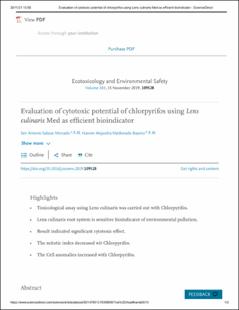Evaluation of cytotoxic potential of chlorpyrifos using Lens culinaris Med as efficient bioindicator
...
SALAZAR MERCADO, SEIR ANTONIO | 2019-11-15
The aim of this study was to evaluate the cytotoxic effect of different concentrations of chlorpyrifos (CPF), using L. culinaris apical cells as a biological indicator. L. culinaris seeds were exposed to different concentrations of chlorpyrifos (0, 1, 3, 5, 7, 8, 10 and 15 mg L−1) and a control solution based on distilled water. Subsequently, root growth was measured during 24, 48 and 72 h. Therefore, the mitotic index (MI) and the number of cellular abnormalities were determined at 72 h. According to the obtained results, a decrease in root size was observed in the concentrations of T5 (8 mg L−1) and T6 (10 mg L−1). On the other hand, it was evidenced that, through all the evaluated concentrations, the inhibition of mitosis in the concentrations of T5 (8 mg L−1), T6 (10 mg L−1) and T7 (15 mg L−1) was greater than 50%. Additionally, a variety of chromosomal abnormalities were reported, such as Micronuclei, sticky chromosomes in anaphase, chromosome disruption, irregular anaphase, nucleus absence, nuclear lesions, chromosomes grouped in metaphase, anaphase bridges, metaphase sticky chromosomes, present in all concentrations evaluated. Consequently, the presence of micronuclei in the concentrations of 8 mg L−1, 10 mg L−1 and 15 mg L−1 indicates that the CPF is a highly cytotoxic substance to L. culinaris. Therefore, L. culinaris is a plant species that offers a feasible experimental model to be implemented in laboratory studies with the purpose to evaluate the cytotoxic effect of pesticides.
LEER











